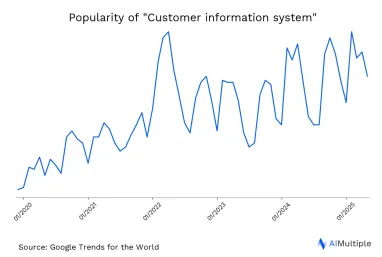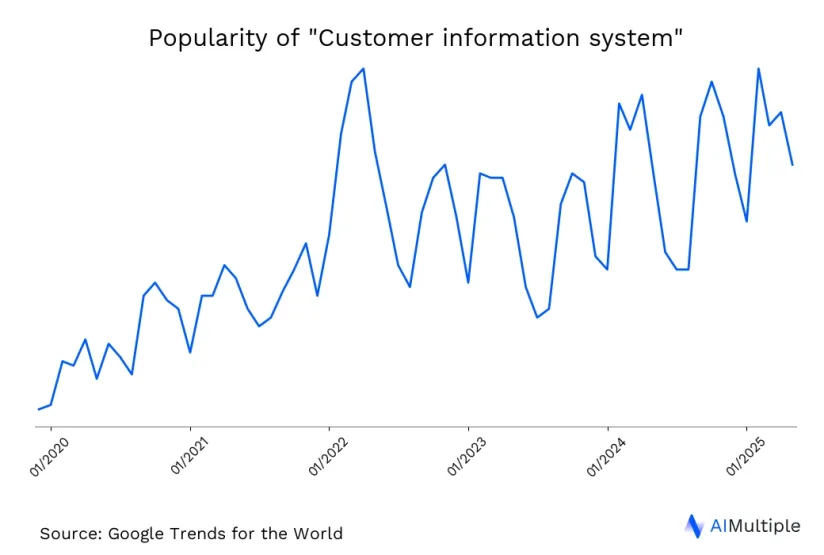Utility companies deploy Customer Information System (CIS) utilities to efficiently manage and organize customer data, offering a centralized platform for quick access to metered consumption, billing processes, and customer services. This is why there’s an upward trend in CIS, as shown by Google Trends data (See Cover image). However, some may overlook CIS’s benefits due to a lack of understanding of its applications and tools.
Explore customer information systems in-detail, focusing on its importance for utilities, use cases, benefits and top tools.
Top CIS solutions
Some vendors offer a CIS solution as a part of their advanced utility systems such as oracle utilities. We identified and listed top CIS tool providers in the table below. The table sorts them based on B2B review numbers obtained from Gartner, ensuring that user reviews for each vendor are available on the platform.
| Vendor | Review |
|---|---|
| Oracle Utilities | 4.4/5.0 based on 21 reviews |
| efluid by efluid SAS | 4.5/5.0 based on 10 reviews |
| Umax by Itineris | 4.8/5.0 based on 9 reviews |
| Net@Suite by Engineering | 4.5/5.0 based on 9 reviews |
| SAP Utilities | 4.1/5.0 based on 7 reviews |
| Smartflex CIS by Open International | 5.0/5.0 based on 7 reviews |
| Indra Customer Management System(InCMS) | 3.9/5.0 based on 7 reviews |
| Fluentgrid | 4.3/5.0 based on 6 reviews |
| Cayenta CIS | 3.9/5.0 based on 5 reviews |
| CIS Infinity by Advanced Utility Systems | 4.8/5.0 based on 4 reviews |
| Gentrack Velocity | 4.0/5.0 based on 2 reviews |
| Mecoms by Ferranti | 4.1/5.0 based on 6 reviews |
| HUB by Hansen | 3.0/5.0 based on 1 reviews |
Complementary technologies under CIS
CIS systems can integrate to cutting edge technologies to manage complex billing and service orders, such as:
Workload automation (WLA) and job scheduling
WLA efficiently schedules, monitors, and automates various tasks within the CIS, optimizing the utility workflow. This integration ensures that critical tasks are executed in a timely and error-free manner, contributing to improved operational efficiency, reduced manual intervention, and enhanced overall customer service.
The combination of CIS and WLA results in a sophisticated system capable of managing intricate billing and service order requirements.
Explore top workload automation tools in our objective and data-driven benchmarking.
Advanced metering infrastructure (AMI)
AMI allows utilities to collect real-time data from smart meters, providing detailed insights into customer energy consumption. The integration with CIS enables utilities to use this data for precise billing, offering customers accurate and timely information about their energy usage.
Using these tools together ensures that billing processes are aligned with actual consumption patterns, promoting transparency and customer satisfaction.
Explore more on Advanced metering infrastructure tools in our comprehensive article.
Customer Relationship Management (CRM)
Customer Relationship Management (CRM) is a technology and strategy that businesses use to manage and analyze customer interactions and data throughout the customer lifecycle, aiming to improve relationships, customer retention, and sales growth. Integration with CRM systems offers a comprehensive perspective on customer interactions, preferences, and history. This integration
What is customer information system utilities and its capabilities?
CIS in utilities refers to specialized software packages employed by utility companies to streamline and optimize various aspects of their operations. These systems are designed to address challenges related to managing metered consumption, billing processes, and customer services efficiently.
CIS utilities functions include:
- Meter-to-cash flow management features, such as order processing, account maintenance, billing, accounts receivable, credit collection, statement preparation, product/services management, and payment processing.
- Interactive customer services, such as call centers, voice response units, and interactive voice response functionalities.
- Digital engagement channels, such as social media and chatbots.
- Customer data management functions, like monitoring, storing and categorizing rate structures, customer bills, service requests, and customer changes.
- Customer relationship management (CRM) through documenting and tracking customer interaction.
- Integration to other utility applications via prebuilt and standard interfaces for seamless integration, irrespective of their existing technology infrastructure.
7 Steps to understand how CIS works
By leveraging CIS utilities, companies can seamlessly:
- Access raw data: CIS begins by accessing raw data from various sources within the utility company. This includes data related to metered consumption, customer information, billing details, and other relevant parameters.
- Retrieve unified data: The system consolidates information from disparate sources, creating a unified database. This step ensures that all critical data, including rate structures, customer bills, service requests, and account changes, is accessible in one central location.
- Enable segmentation and organization: CIS efficiently segments vast amounts of data into manageable components. This segmentation aids in identifying errors and enables utilities to organize extensive service areas and rapidly expanding customer groups effectively.
- Track customer interaction: One of the key functionalities of CIS is the ability to track and document all customer interactions. This includes calls to the call center, responses to voice-activated systems, and interactions with digital engagement channels like social media and chatbots.
- Integrates to CRM: CIS integrates seamlessly with Customer Relationship Management (CRM) systems. This integration streamlines the operation systems, making it easy for utilities to assign, schedule, and track all consumer-based activities. This includes managing smart meters, collections services, or any system-generated services.
- Orchestrate billing processes: The system incorporates advanced billing and rating engines. It consolidates multiple accounts, combines services and products into a single bill, and provides flexibility in formatting. Additionally, it supports advance billing, simplifying the collection process and accommodating customer preferences.
- Provide customer profiling: CIS offers a comprehensive 360° view of the customer. This feature allows utilities to support, track, and access consumer data from a single entity. It provides utilities with raw data for designing, managing, and executing marketing programs while tracking the results of adopted strategies.
Top 4 reasons why CIS matters
The latest customer surveys show that utility company challenges are heavily focused on customer relationship management field. These challenges include:
- Decentralized customer data: 41% of survey respondents find the biggest pain point when different CSRs give different answers, as CSRs navigate multiple screens without simultaneous access to critical customer information. This problem hinders issue resolution and require a system of record, including service order history, payment history, usage analysis, and other relevant data. 1
- Lack of personalization in the self-service channels: 67% of customers prefer self-service options, but many utilities fall short on personalized recommendations in self-service. Utility firms are urged to leverage next-best actions for chatbots, mobile apps, and web portals and utilize advanced analytics and customer insights from unified data. 2
- Disconnected customer experience: Microsoft found that 72% of callers expect customer service representatives (CSRs) to know that they are a customer, and their product and service history. However, CSRs often struggle to connect real-time insights across all customer channels and deliver personalized recommendations. 3
- Proactive notifications: Utility customer reports show that 80% of customers demand for high bill notifications, proposing a proactive and personalized next-best actions. This way, utility customers could reduce the number of billing and financial assistance calls. 4
TOP 7 CIS use cases
Top applications of CIS include:
Managing customer information efficiently
One significant challenge for utilities is to manage metered consumption data, customer information and program details, including payment plans and terms of service. This is especially problematic when dealing with a large, geographically dispersed customer base.
A modern CIS billing system efficiently manages, schedules, monitors and stores various customer-related tasks, including collections, equipment requirements, work orders, statuses, meter checks, customer bills, and service requests. Additionally, modern CIS platforms easily adapt to intricate local or state-based regulations and rate plans.
This system allows businesses to segment vast amounts of information, aiding in error identification and ensuring excellent service delivery. It navigates and organizes extensive service areas and rapidly expanding customer groups.
For example, Puget Sound Energy launched the “Get to Zero” initiative, a multi-channel marketing campaign focused on updating customer information, educating them on self-service options, and providing outage notifications. This effort led to a five-fold increase in collected customer mobile numbers, a 32% boost in satisfaction scores, and helped prevent outages by proactively notifying customers and resolving issues.5
Customer relationship management
Repeatedly providing the same information to different customer service representatives can be a frustrating experience for customers. In fact, 89% of customers believe that companies need to offer a consistent customer experience across channels. 6
Modern utility customer information systems eliminate the need for customers to repeat information, offering a 360⁰ view of customer interactions. Documenting and tracking all customer interactions equips CSRs with the necessary information for effective issue resolution, leading to improved customer satisfaction.
Improving Operations and Customer Service
Customer information systems leverage customer data to improve customer service
Improving call center performance
A single, intuitive user interface provides call center agents complete visibility, enabling more efficient, consistent, and comprehensive customer care. This addresses the challenge of managing customer information and enhances CRM by reducing the frustration of repeated information.
For instance, Arizona Public Service (APS) improved customer satisfaction by providing personalized cost-saving recommendations through Uplight’s Residential Online Assessment. This led to a 5% increase in overall customer satisfaction and a 14% boost in satisfaction with issue resolution during the summer. 7
Providing personalized service
Unified meter, account, service, and communications data insights enable recommending the best programs, products, and next actions to customers. This contributes to load management and corresponds to customer expectations, enhancing the overall customer experience.
Using Customer Information Systems (CIS), utilities analyze customer data to implement automated notifications. This proactive approach reduces contact center calls by 19% by informing customers about billing or service updates.8 By streamlining communication, utilities reduce the need for frequent contact center inquiries, improving efficiency and customer experience.
Reducing call-handling time
An intelligent agent portal with automated workflows reduces call-handling time, ensuring accuracy and efficiency in delivering better service to customers. This aligns with the challenge of inefficient call center operations and contributes to enhancing the overall customer experience.
Billing questions, especially regarding Low-to-Moderate-Income (LMI) programs, can be challenging for CSRs, leading to missed opportunities and lost revenue. Utilizing CIS enables CSRs to swiftly identify and suggest suitable programs like energy efficiency, payment extensions, plans, federal rate assistance, or community aid, ensuring flexible billing aligned with customer needs.
Automating manual processes
Built-in modules for service order management, operational device management, and native integrations automate business processes, reducing manual workloads and enhancing customer service delivery.
Utility providers that automated their customer support and adopted low-touch channels decreased their costs by 30%. 9
Enhancing Chatbot Efficiency for Complex Customer Issues
To optimize customer service, utilities integrate comprehensive customer information into the Customer Information System (CIS). This data integration empowers well-executed chatbots, capable of efficiently resolving over 80% of chat sessions. 10
By having access to a wealth of customer data, chatbots effectively handle routine inquiries, freeing up valuable time for customer agents to focus on addressing more complex and intricate customer issues.
Further readings
Explore all technologies utilized in utility automation:
- Compare 10 SAP Utility Solutions based on 3,000+ reviews
- 10 Tips to Master Utility Asset Management
- Compare 10 Smart Meter Solutions based on 500+ reviews
External sources
- 1. “The Four Challenges of Modern Utility Customer Care.” Uplight. 2019. Accessed at January 30, 2024.
- 2. Ibid., pp 6.
- 3. Ibid., pp 3.
- 4. Ibid., pp 8.
- 5. Ibid., pp 7.
- 6. Ibid.Ibid., pp 7.
- 7. Ibid., pp 14.
- 8. Ibid., pp 8.
- 9. Ibid., pp 6.
- 10. Ibid., pp 6.




Comments
Your email address will not be published. All fields are required.